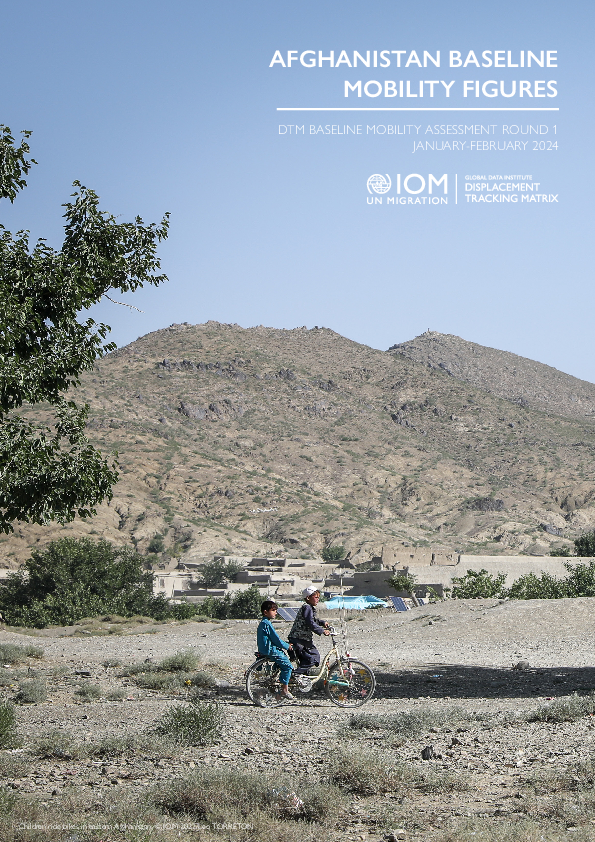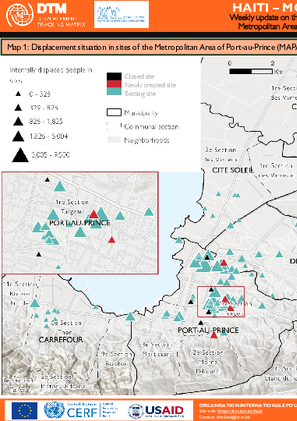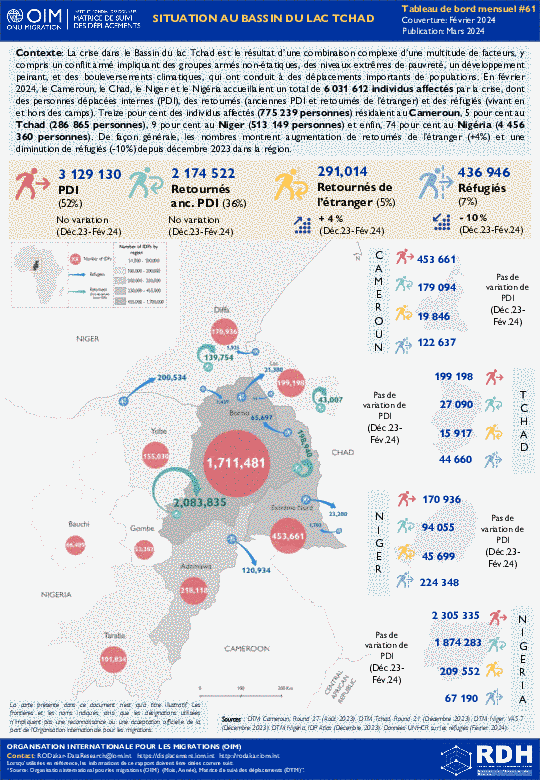-
Countries
-
Data and Analysis
-
Special Focus
-
Crisis Responses
Baseline Assessment
Contact
DTMUkraine@iom.int
Location
Ukraine
Activity
- Mobility Tracking
- Baseline Assessment
Period Covered
Jan 01 2024 -Jan 31 2024
The data collected for the Area Baseline Assessment Round 32 reflects the up-to-date local administrative register of the IDP population as of 31 January 2024, equivalent to a total of 3,509,147 registered IDPs. Registered IDP figures were collected for 1,098 hromadas (83% of all hromadas covered in Ukrainian government-controlled areas), across 108 raions and 23 oblasts. Data disaggregated by age, sex and disability status were provided for around 83 per cent of the administrative units covered.
A more detailed version of this dataset at the Hromada level is available. To get access, kindly click on the 'Request Access' button.
Population Groups
IDPs
Survey Methodology
Unit of Analysis Or Observation
Admin Area 2
Site or Location
Type of Survey or Assessment
Key Informant
Keywords
Geographical Scope Partial Coverage
Administrative boundaries with available data
The current dataset covers the following administrative boundaries

Contact
DTMUkraine@iom.int
Language
English
Location
Ukraine
Period Covered
Feb 01 2024
Feb 29 2024
Activity
- Baseline Assessment
The Registered IDP Area Baseline Assessment provides granular data on the number and geographic location of officially registered internally displaced people (IDPs). This report assesses registered IDP presence at the hromada level, also mapping the recorded change since the previous round.
The data collected for the Area Baseline Assessment Round 33 reflects the up-to-date local administrative register of the IDP population as of 29 February 2024, equivalent to a total of 3,413,472 registered IDPs. Registered IDP figures were collected for 1,098 hromadas (83% of all hromadas covered in Ukrainian government-controlled areas), across 108 raions and 23 oblasts. Data disaggregated by age, sex and disability status were provided for around 83 per cent of the administrative units covered.
Contact
IOM DTM Yemen, iomyemendtm@iom.int
Location
Yemen
Activity
- Flow Monitoring
- Mobility Tracking
- Baseline Assessment
Period Covered
Feb 01 2024 -Feb 29 2024
In February 2024, IOM Yemen DTM recorded 1,744 migrants entering Yemen, an increase of less than one per cent compared to last month (1,737). Shabwah typically serves as an entry point for migrants from Somalia and rarely sees migrants departing from Djibouti due to the considerable distance between Djibouti and Shabwah. Thus, Shabwah was the arrival destination for all migrants departed from Bari, Somalia (1,744). The overall number of migrants entering through Shabwah has increased by less than one per cent in February (1,744) compared to January 2024 (1,736).
According to DTM, conflict-induced movements constituted 56 per cent of all incoming movements in February 2024. These movements were exclusively observed in Shabwah, originating from Bari, Somalia (22% children, 21% women, and 58% men).
DTM observed a decrease in Yemeni returnees by 39 per cent in February (3,116) compared to January (5,148). This decrease might be attributed to the fact that more people travel to the Kingdom of Saudi Arabia annually to perform the Omrah during the months of Sha'aban and Ramadan. This results in heavy crowding at Al-Wadea'ah land border and causes the Saudi authorities to concentrate more on those entering the country irregularly than on the process of deportation.
The deteriorating humanitarian crisis in Yemen has forced many migrants to make the difficult decision to return to their home countries in the Horn of Africa. Others are reported to have been deported by authorities. DTM recorded that in February 2024, a total of 2,326 migrants either opted to take the risky journey back or were deported by boat from Yemen. This group consisted of 92 per cent men, 4 per cent women, and 4 per cent children.
Additionally, the Djibouti DTM team documented that during the same period, 1,730 migrants (1,570 males and 160 females) embarked on a dangerous journey back home by boat from Yemen. These numbers highlight the significant challenges faced by migrants in Yemen and the desperate situations that have driven them to undertake perilous voyages across the sea.
Population Groups
Survey Methodology
Unit of Analysis Or Observation
Type of Survey or Assessment
Keywords
Geographical Scope
Administrative boundaries with available data
The current dataset covers the following administrative boundaries

Contact
IOM DTM Yemen, iomyemendtm@iom.int
Language
Arabic
Location
Yemen
Period Covered
Feb 01 2024
Feb 29 2024
Activity
- Flow Monitoring
- Mobility Tracking
- Baseline Assessment
يقوم سجل مراقبة التدفق التابع لمصفوفة تتبع النزوح (FMR) التابع للمنظمة الدولية للهجرة في اليمن بمراقبة وصول المهاجرين على الحدود الساحلية الجنوبية ومواقع العودة اليمنية على الحدود الشمالية لليمن مع المملكة العربية السعودية. يقوم القائمون على التعداد الموجودون في نقاط مراقبة التدفق بتسجيل المهاجرين الوافدين والمواطنين اليمنيين العائدين لتحديد أنماط الهجرة المختلفة، ولتقديم تقديرات كمية للمساعدة في تحديد عدد المهاجرين غير الشرعيين الذين يدخلون البلاد.
لا تمثل الهجرة القسرية جميع التدفقات في اليمن وينبغي فهمها على أنها مؤشر فقط لاتجاهات الهجرة للعدد الإجمالي غير المعروف للمهاجرين الذين يصلون إلى اليمن عند نقاط الهجرة خلال الإطار الزمني المحدد. تحد قيود الوصول من القدرة على جمع البيانات في بعض نقاط وصول المهاجرين.
وفي محاولة للحد من تدفق المهاجرين الداخلين إلى اليمن، والذي يعبر البلاد بشكل أساسي متجهاً نحو المملكة العربية السعودية ودول الخليج الأخرى، بدأت حملة عسكرية مشتركة في أغسطس 2023. ركزت هذه الحملة على ساحل محافظة لحج، نقطة دخول مهمة لعدد كبير من المهاجرين (بحد أقصى 15,714 مهاجرًا في مارس 2023). احتجز الجيش المهربين وطارد قواربهم، مما أدى إلى انخفاض مطرد في تدفق المهاجرين عبر هذا الساحل حتى توقف تماما خلال الأشهر الخمسة الماضية، مع استثناء واحد في منتصف ديسمبر/كانون الأول 2023 عندما تمكن قارب يحمل 110 مهاجرين من الوصول إلى الساحل. أرض.
في فبراير 2024، سجلت مصفوفة تتبع النزوح التابعة للمنظمة الدولية للهجرة في اليمن دخول 1,744 مهاجرًا إلى اليمن، بزيادة أقل من واحد بالمائة مقارنة بالشهر الماضي (1,737). تعتبر شبوة عادة نقطة دخول للمهاجرين من الصومال ونادرا ما تشهد مغادرة المهاجرين من جيبوتي بسبب المسافة الكبيرة بين جيبوتي وشبوة. وهكذا، كانت شبوة وجهة الوصول لجميع المهاجرين المغادرين من باري، الصومال (1,744). ارتفع العدد الإجمالي للمهاجرين الذين يدخلون عبر شبوة بنسبة أقل من واحد في المائة في فبراير (1,744) مقارنة بشهر يناير 2024 (1,736).
وفقًا لمصفوفة تتبع النزوح، شكلت الحركات الناجمة عن النزاع 56% من جميع الحركات الواردة في فبراير 2024. وقد لوحظت هذه الحركات حصريًا في شبوة، مصدرها باري، الصومال (22% أطفال، 21% نساء، 58% رجال).
ولاحظت مصفوفة تتبع النزوح انخفاضاً في عدد العائدين اليمنيين بنسبة 39 بالمائة في فبراير (3,116) مقارنة بشهر يناير (5,148). وقد يعزى هذا الانخفاض إلى تزايد أعداد المسافرين إلى المملكة العربية السعودية سنويا لأداء العمرة خلال شهري شعبان ورمضان. ويؤدي ذلك إلى ازدحام شديد على حدود الوديعة البرية، ويجعل السلطات السعودية تركز أكثر على الداخلين إلى البلاد بطريقة غير نظامية أكثر من التركيز على عملية الترحيل.
أجبرت الأزمة الإنسانية المتدهورة في اليمن العديد من المهاجرين على اتخاذ القرار الصعب بالعودة إلى بلدانهم الأصلية في القرن الأفريقي. وبحسب ما ورد قامت السلطات بترحيل آخرين. سجلت مصفوفة تتبع النزوح أنه في فبراير 2024، اختار ما مجموعه 2,326 مهاجرًا إما القيام برحلة العودة المحفوفة بالمخاطر أو تم ترحيلهم بالقوارب من اليمن. وتتكون هذه المجموعة من 92 في المائة رجال، و4 في المائة نساء، و4 في المائة أطفال.
بالإضافة إلى ذلك، وثّق فريق مصفوفة تتبع النزوح في جيبوتي أنه خلال الفترة نفسها، انطلق 1,730 مهاجرًا (1,570 ذكرًا و160 أنثى) في رحلة خطيرة للعودة إلى وطنهم بالقوارب من اليمن. تسلط هذه الأرقام الضوء على التحديات الكبيرة التي يواجهها المهاجرون في اليمن والأوضاع اليائسة التي دفعتهم إلى القيام برحلات محفوفة بالمخاطر عبر البحر.

Contact
IOM DTM Yemen, iomyemendtm@iom.int
Language
English
Location
Yemen
Period Covered
Feb 01 2024
Feb 29 2024
Activity
- Flow Monitoring
- Mobility Tracking
- Baseline Assessment
IOM Yemen DTM’s Flow Monitoring Registry (FMR) monitors migrant arrivals on the southern coastal border and Yemeni return locations on Yemen's northern border with the Kingdom of Saudi Arabia (KSA). Enumerators placed at Flow Monitoring Points (FMPs) record migrant arrivals and returning Yemeni nationals to identify different patterns of migration, and to provide quantitative estimates to help define the population of irregular migrants entering the country.
FMR is not representative of all flows in Yemen and should be understood as only indicative of migration trends of the unknown total number of migrants arriving in Yemen at FMPs during the time frame indicated. Access constraints limit the ability to collect data at some migrant arrival points.
In an effort to reduce the flow of migrants entering Yemen, which primarily crosses through the country heading towards the Kingdom of Saudi Arabia and other Gulf countries, a joint military campaign was initiated in August 2023. This campaign focused on the coast of Lahj governorate, a significant entry point for a large number of migrants (max. 15,714 migrants in March 2023). The military detained smugglers and pursued their boats, leading to a steady decrease in the flow of migrants through this coast until it ceased entirely during the last five months, with a single exception in the middle of December 2023 when a boat carrying 110 migrants managed to land.
In February 2024, IOM Yemen DTM recorded 1,744 migrants entering Yemen, an increase of less than one per cent compared to last month (1,737). Shabwah typically serves as an entry point for migrants from Somalia and rarely sees migrants departing from Djibouti due to the considerable distance between Djibouti and Shabwah. Thus, Shabwah was the arrival destination for all migrants departed from Bari, Somalia (1,744). The overall number of migrants entering through Shabwah has increased by less than one per cent in February (1,744) compared to January 2024 (1,736).
According to DTM, conflict-induced movements constituted 56 per cent of all incoming movements in February 2024. These movements were exclusively observed in Shabwah, originating from Bari, Somalia (22% children, 21% women, and 58% men).
DTM observed a decrease in Yemeni returnees by 39 per cent in February (3,116) compared to January (5,148). This decrease might be attributed to the fact that more people travel to the Kingdom of Saudi Arabia annually to perform the Omrah during the months of Sha'aban and Ramadan. This results in heavy crowding at Al-Wadea'ah land border and causes the Saudi authorities to concentrate more on those entering the country irregularly than on the process of deportation.
The deteriorating humanitarian crisis in Yemen has forced many migrants to make the difficult decision to return to their home countries in the Horn of Africa. Others are reported to have been deported by authorities. DTM recorded that in February 2024, a total of 2,326 migrants either opted to take the risky journey back or were deported by boat from Yemen. This group consisted of 92 per cent men, 4 per cent women, and 4 per cent children.
Additionally, the Djibouti DTM team documented that during the same period, 1,730 migrants (1,570 males and 160 females) embarked on a dangerous journey back home by boat from Yemen. These numbers highlight the significant challenges faced by migrants in Yemen and the desperate situations that have driven them to undertake perilous voyages across the sea.

Contact
DTMAfghanistan@iom.int
Language
English
Location
Afghanistan
Period Covered
Jan 25 2024
Feb 29 2024
Activity
- Mobility Tracking
- Baseline Assessment
IOM Afghanistan launched the first round of the DTM Baseline Area Assessment B1 in January 2024 as part of its ongoing efforts to collect crucial data on population mobility dynamics, specifically displacement and returns. In particular, the B1 activity seeks to map the presence of mobile population groups, such as Internally Displaced Persons (IDPs), returnees, and internal migrants, to enable further understanding of conditions, vulnerabilities, and humanitarian needs through targeted data collection and analysis. After implementation of the B1, a subsequent assessment, the Baseline Village Assessment B2, will target all locations that report presence of mobile population groups to verify the results of the B1 and collect more granular information on reasons for mobility, shelter types, and places of origin.
The following report covers data collected for the B1 in January and February 2024, during which the IOM DTM Afghanistan team was able to completely cover two thirds (23 out of 34) of the provinces in the country. Further data collection to cover the remaining provinces is anticipated in the coming days. For a provisional look at baseline mobility figures for all 34 provinces, see the annex on pages 9 and 10, which combines the current B1 data with data collected during previous DTM activities.

Contact
DTM Haiti, dtmhaiti@iom.int
Language
English
Location
Haiti
Period Covered
Mar 09 2024
Mar 15 2024
Activity
- Mobility Tracking
- Site Assessment
- Baseline Assessment
To continually inform humanitarian responses in the MAPAP sites, the CCCM cluster and DTM conduct weekly data collections in these sites to update information on the displacement situation in the sites.
This report presents the situation as of 15 March 2024. A total of 84 sites are active in the MAPAP hosting 86,040 IDPs, this represents 12% less compared to the previous week.
Contact
DTM Sudan, DTMSudan@iom.int
Location
Sudan
Activity
- Mobility Tracking
- Baseline Assessment
Period Covered
Feb 29 2024 -Mar 07 2024
- DTM Sudan estimates that 6,467,700 individuals (1,289,341 households) were recently internally displaced.
- The IDP caseload was observed in 6,968 locations across all of Sudan’s 18 states.
- The highest proportions of IDPs were observed across South Darfur (12%), River Nile (11%), and East Darfur (10%).
- Field teams reported that the IDPs observed were originally displaced from twelve states. The majority (3,564,234 IDPs, 55%) were reportedly displaced from Khartoum state; followed by South Darfur (15%), North Darfur (9%), Aj Jazirah (8%), Central Darfur (5%), West Darfur (4%), South Kordofan (2%), East Darfur (1%), West Kordofan (1%), North Kordofan (1%), Sennar (<1%) and White Nile (<1%).
- IOM-DTM also reported that an estimated 1,918,309 mixed cross-border movements were made into neighbouring countries.
- This product provides brief insights into those displaced in Sudan post-15 April 2023. For more granular information on the IDP caseload and the displacement context, please see IOM-DTM's Monthly Displacement Overview 06.
A more detailed version of this dataset is available, to get access kindly click on the 'Request Access' button
Population Groups
IDPs
Survey Methodology
Unit of Analysis Or Observation
Site or Location
Type of Survey or Assessment
Key Informant
Keywords
Geographical Scope Partial Coverage
Administrative boundaries with available data
The current dataset covers the following administrative boundaries
The crisis currently affecting the Lake Chad Basin states results from a complex combination of factors, including conflict with non-state armed groups, extreme poverty, underdevelopment and a changing climate, which together have triggered significant displacement of populations. As of February 2024, Cameroon, Chad, Niger and Nigeria were hosting an estimated 6,031,612 affected individuals made up of internally displaced persons (IDPs), returnees (former IDPs and returnees from abroad) and refugees (both in- and out-of-camp). Thirteen per cent of the affected population (775,238 individuals) were located in Cameroon, while 5 per cent resided in Chad (286,865 individuals), 9 per cent in Niger (513,149 individuals) and finally, 74 per cent in Nigeria (4,456,360 individuals). Overall, the numbers show increases in returnees from abroad (+4%) and a decrease in refugees (-10%) since December 2023.
La crise dans le Bassin du lac Tchad est le résultat d’une combinaison complexe d’une multitude de facteurs, y compris un conflit armé impliquant des groupes armés non-étatiques, des niveaux extrêmes de pauvreté, un développement peinant, et des bouleversements climatiques, qui ont conduit à des déplacements importants de populations. En février 2024, le Cameroun, le Chad, le Niger et le Nigéria accueillaient un total de 6 031 612 individus affectés par la crise, dont des personnes déplacées internes (PDI), des retournés (anciennes PDI et retournés de l’étranger) et des réfugiés (vivant en et hors des camps). Treize pour cent des individus affectés (775 239 personnes) résidaient au Cameroun, 5 pour cent au Tchad (286 865 personnes), 9 pour cent au Niger (513 149 personnes) et enfin, 74 pour cent au Nigéria (4 456 360 personnes). De façon générale, les nombres montrent augmentation de retournés de l’étranger (+4%) et une diminution de réfugiés (-10%) depuis décembre 2023 dans la région.
Pagination
- Previous page
- Page 38
- Next page


